Essential Scuba Diving Gear for Beginners
Embarking on your scuba diving journey is an exciting adventure, and having the right gear is essential for a safe and enjoyable experience underwater. As a beginner, you might feel overwhelmed by the array of scuba equipment available, but don’t worry, we’re here to help you navigate through the essentials.
In this section, we’ll cover the basic gear you need to start diving, including masks, snorkels, fins, wetsuits or drysuits, buoyancy control devices (BCDs), regulators, and dive computers.
First and foremost, a well-fitting scuba mask is crucial, as it provides a clear view of the underwater world and ensures a comfortable fit on your face.
A snorkel is a simple yet indispensable piece of equipment that allows you to breathe on the surface without wasting your precious tank air. Fins are vital for efficient underwater propulsion, while dive boots protect your feet and provide support during shore entries and exits.
Temperature control is essential for a comfortable dive, so choosing the right wetsuit or drysuit is a critical decision. A wetsuit provides thermal insulation through a layer of neoprene, while a drysuit traps a layer of air and keeps you completely dry in colder waters.
A buoyancy control device (BCD) is a piece of equipment that enables you to adjust your buoyancy underwater, while a regulator is responsible for delivering air from your tank to your mouth.
Lastly, a dive computer or a set of analog gauges helps you monitor crucial dive information, such as depth, time, and remaining air supply. These devices assist you in adhering to safe diving practices and ensuring an enjoyable experience.
Now that you have a basic understanding of the essential scuba gear, let’s dive deeper into each component, starting with choosing the right mask and snorkel for your underwater adventures.
Choosing the Right Scuba Mask and Snorkel
A properly fitting scuba mask and a reliable snorkel are fundamental to enjoying your underwater adventures. In this section, we’ll provide expert tips and recommendations on how to choose the perfect mask and snorkel for your diving needs.
Scuba Mask:
When selecting a scuba mask, the most important factor is fit.
A well-fitting mask should create a watertight seal around your face without causing discomfort.
To test the fit, follow these steps:
- Place the mask on your face without using the strap.
- Inhale gently through your nose to create a vacuum.
- The mask should stay in place without the need for the strap.
In addition to fit, consider the following features:
- Lens: Masks with a single lens offer an uninterrupted field of view, while those with two lenses allow for prescription lenses. Tempered glass lenses are more durable and less prone to scratching compared to plastic lenses.
- Frame: Frameless masks are more compact and lighter, while framed masks are sturdier and offer a more secure fit.
- Skirt: Look for a mask with a high-quality silicone skirt, as it provides a better seal and lasts longer than rubber or PVC skirts.
- Strap and Buckles: Choose a mask with an easily adjustable strap and reliable buckles that won’t slip during your dive.
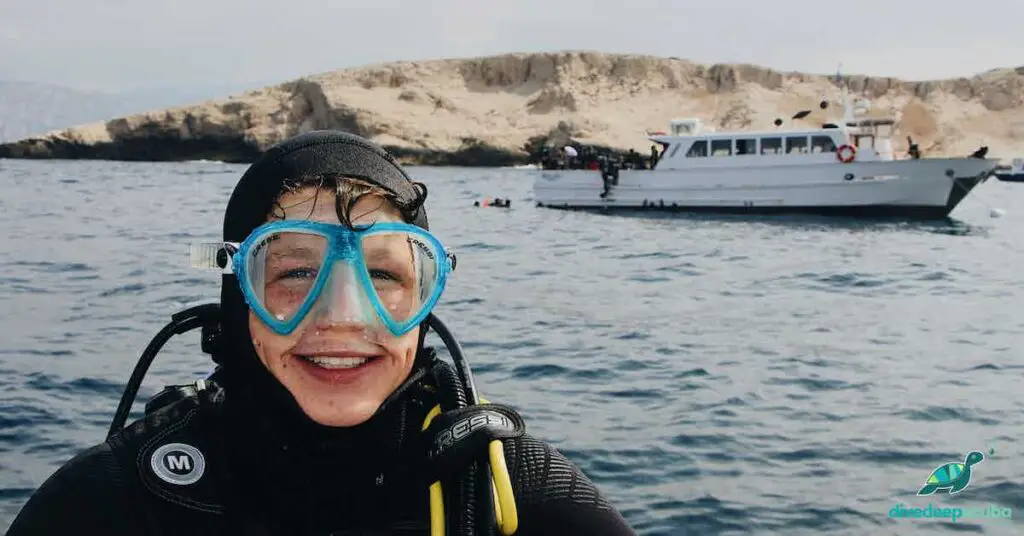
Snorkel:
When selecting a snorkel, consider these features:
- Type: There are three main types of snorkels: classic, semi-dry, and dry. Classic snorkels are the simplest, with an open top and no special features. Semi-dry snorkels have a splash guard on top to prevent water from entering, while dry snorkels have a float mechanism that seals the tube when submerged.
- Purge Valve: A snorkel with a purge valve at the bottom allows for easier clearing of water.
- Mouthpiece: Look for a snorkel with a comfortable silicone mouthpiece that doesn’t cause jaw fatigue.
- Attachment: Ensure the snorkel has a secure attachment mechanism to connect it to your mask.
By following these expert tips and recommendations, you’ll be able to choose the perfect scuba mask and snorkel for your underwater escapades.
Up next, let’s explore how to select the ideal fins and dive boots for an effortless diving experience.
Selecting the Perfect Fins and Dive Boots
Fins and dive boots are essential components of your scuba gear setup, providing efficient propulsion and comfort during your dives.
In this section, we’ll help you choose the perfect fins and dive boots to enhance your underwater experience.
Fins:
When selecting fins, consider the following factors:
- Style: There are two main styles of fins – open-heel and full-foot. Open-heel fins feature an adjustable strap and are worn with dive boots, while full-foot fins are designed to be worn barefoot or with thin neoprene socks. Open-heel fins are more versatile and suitable for various diving conditions, whereas full-foot fins are ideal for warm water and snorkeling.
- Blade Type: Fins come with either paddle or split blades. Paddle fins have a solid blade and provide more power, while split fins offer better efficiency and are easier on your leg muscles.
- Stiffness: Stiffer fins generate more power but require stronger leg muscles, while more flexible fins are easier to use but may not provide as much propulsion. As a beginner, you may prefer a more flexible fin for comfort and ease of use.
- Size: Choose fins that fit snugly but don’t pinch or cause discomfort. Your feet should be well-supported without excessive movement inside the fin pocket.
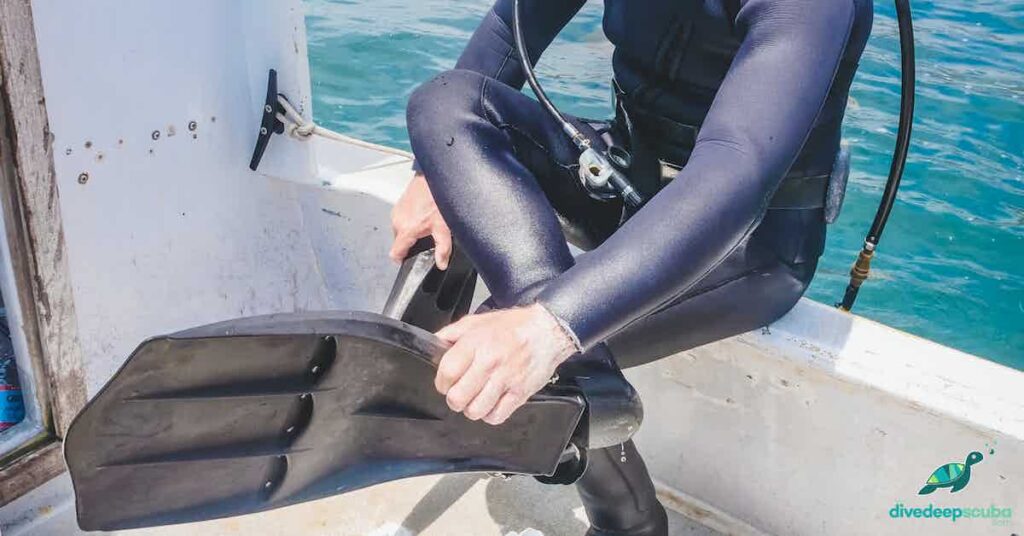
Dive Boots:
When selecting dive boots, consider the following factors:
- Fit: A well-fitting dive boot should be snug but not too tight, with enough room for your toes to move slightly. If you’re wearing open-heel fins, ensure your dive boots fit comfortably within the fin pocket.
- Thickness: Dive boots come in various thicknesses, typically ranging from 3mm to 7mm. Thicker boots provide better insulation for cold water diving, while thinner boots are suitable for warmer conditions.
- Sole: Dive boots have either hard or soft soles. Hard-soled boots offer better support and protection on rocky or uneven surfaces, while soft-soled boots are lighter and more comfortable for swimming.
- Closure: Choose boots with a secure closure system, such as a zipper, Velcro, or laces, to ensure they stay in place during your dives.
With these expert tips and recommendations, you’ll be well-equipped to select the perfect fins and dive boots for your underwater adventures.
Next up, let’s dive into finding a comfortable and functional wetsuit or drysuit to keep you warm in various diving conditions.
Finding a Comfortable and Functional Wetsuit or Drysuit
Maintaining a comfortable body temperature during your dives is crucial for an enjoyable experience.
Wetsuits and drysuits are designed to provide thermal insulation, allowing you to dive in various water temperatures.
In this section, we’ll guide you through selecting the ideal wetsuit or drysuit for your diving needs.
Wetsuits:
When choosing a wetsuit, consider the following factors:
- Thickness: Wetsuits come in various thicknesses, generally ranging from 2mm to 7mm. Thicker wetsuits provide better insulation for colder water, while thinner wetsuits are suitable for warmer conditions. Consider the water temperatures you’ll be diving in when selecting your wetsuit thickness.
- Style: Wetsuits are available in several styles, including full suits, shorties, spring suits, and separates. Full suits cover your entire body and offer the most protection, while shorties and spring suits expose your arms and/or legs, making them ideal for warmer water. Separates, such as farmer johns and jackets, can be combined for versatility in different conditions.
- Fit: A well-fitting wetsuit should be snug but not restrictive, allowing for a full range of motion. Keep in mind that wetsuits will stretch slightly when wet, so opt for a snug fit rather than a loose one.
- Material: Most wetsuits are made from neoprene, which provides excellent insulation and flexibility. Look for a wetsuit with high-quality neoprene and reinforced seams for durability.
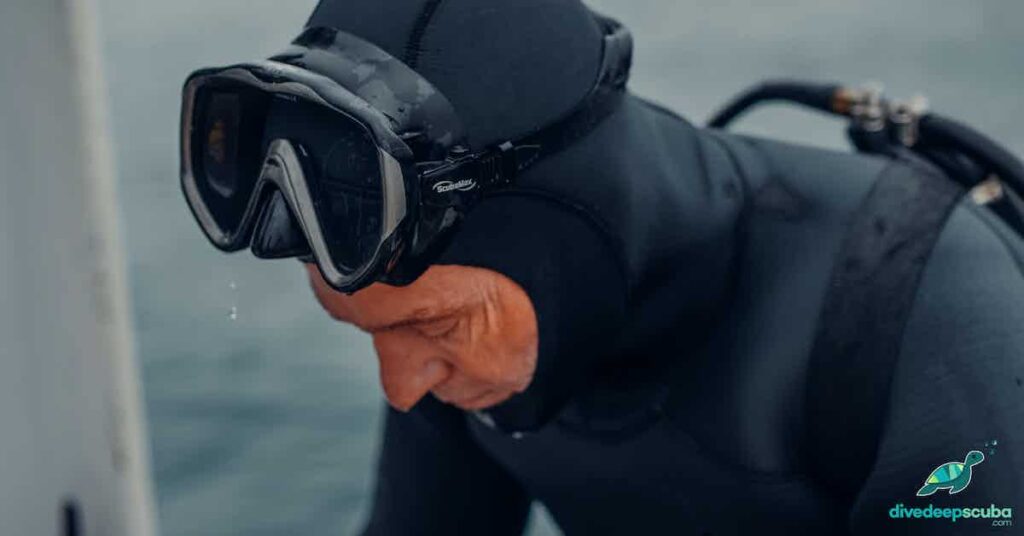
Drysuits:
When choosing a drysuit, consider the following factors:
- Material: Drysuits are typically made from crushed neoprene, trilaminate, or vulcanized rubber. Crushed neoprene drysuits are durable and provide excellent insulation, while trilaminate drysuits are lightweight and offer better flexibility. Vulcanized rubber drysuits are less common but offer excellent durability and chemical resistance.
- Fit: A properly fitting drysuit should allow for comfortable layering of insulating garments underneath without restricting movement. Ensure there is enough room to wear thermal layers and still move freely.
- Seals: Drysuits have seals at the neck and wrists to prevent water entry. Latex seals offer a better seal but are less durable than neoprene seals, which are more comfortable and longer-lasting.
- Valves: Quality drysuits come with inflation and exhaust valves, which allow you to control the amount of air in your suit for buoyancy and comfort.
By following these expert tips and recommendations, you’ll be able to find a comfortable and functional wetsuit or drysuit that suits your diving needs.
Up next, we’ll discuss investing in a high-quality buoyancy control device (BCD) and regulator for a safe and enjoyable dive experience.
Investing in a High-Quality Buoyancy Control Device (BCD) and Regulator
Your buoyancy control device (BCD) and regulator are crucial components of your scuba gear setup, ensuring both safety and comfort during your dives.
In this section, we’ll provide expert tips and recommendations on selecting the right BCD and regulator for your diving needs.
Buoyancy Control Device (BCD):
When choosing a BCD, consider the following factors:
- Style: There are three main styles of BCDs: jacket, back-inflate, and wing. Jacket-style BCDs are the most common and provide an even distribution of buoyancy around your torso. Back-inflate BCDs concentrate buoyancy on your back, offering better horizontal trim. Wing-style BCDs are popular among technical divers and provide a more streamlined profile.
- Fit: A properly fitting BCD should be snug but not restrictive, allowing for a full range of motion. Ensure there is enough room to wear your wetsuit or drysuit underneath without discomfort.
- Lift Capacity: Your BCD’s lift capacity should be sufficient to support your body weight, gear, and the type of diving you’ll be doing. As a beginner, a lift capacity of 20-30 pounds is typically adequate.
- Integrated Weights: Many modern BCDs offer integrated weight systems, eliminating the need for a separate weight belt. This feature provides a more streamlined and comfortable setup.
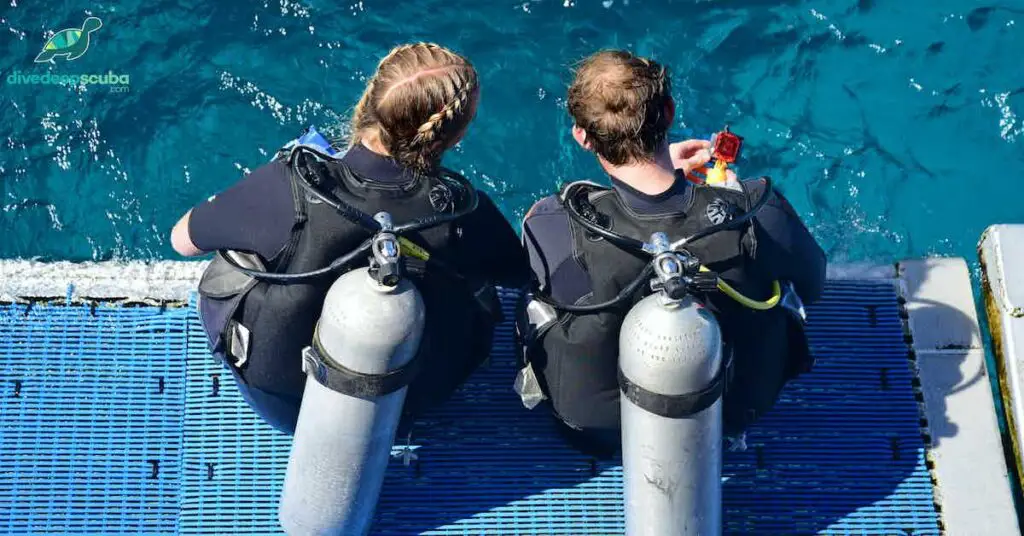
Regulator:
When selecting a regulator, consider the following factors:
- Performance: As a beginner, you’ll want a regulator that offers reliable and consistent performance. Look for a balanced first stage, as it provides consistent airflow regardless of your tank pressure or depth.
- Breathing Comfort: Your regulator should provide a comfortable breathing experience with minimal resistance. Test different regulators to find the one that suits your personal preference.
- Cold Water Performance: If you plan to dive in cold water, ensure your regulator is suitable for cold water diving. Cold water regulators feature environmental sealing and other design elements to prevent freezing and free-flowing.
- Hose Configuration: Consider the hose configuration that best suits your diving style. Most regulators come with a standard hose configuration, but many divers opt for longer hoses or alternate setups for increased flexibility and streamlined profiles.
By investing in a high-quality BCD and regulator, you’ll ensure a safe and enjoyable diving experience.
In the next section, we’ll delve into understanding dive computers and analog gauges to help you monitor crucial dive information.
Understanding Dive Computers and Analog Gauges
Monitoring your dive information is essential for safe and enjoyable underwater exploration.
Dive computers and analog gauges provide critical data, such as depth, dive time, air consumption, and decompression information.
In this section, we’ll discuss the key features to consider when selecting dive computers and analog gauges.
Dive Computers:
When choosing a dive computer, consider the following factors:
- Display: Opt for a dive computer with a clear and easy-to-read display. Large screens with bright backlighting and high contrast are easier to read underwater.
- Modes: Ensure your dive computer supports the diving modes you’ll use, such as air, nitrox, gauge, or freediving. Some dive computers also offer advanced modes for technical diving or rebreathers.
- User Interface: A user-friendly interface makes it easier to navigate your dive computer’s features and settings. Look for intuitive menus and buttons or touchscreens for seamless operation.
- Connectivity: Many modern dive computers offer wireless connectivity, allowing you to download dive logs, update software, or sync with a smartphone app. This feature can be convenient for tracking your diving progress and sharing your adventures.
- Battery: Consider the dive computer’s battery life and whether it has a user-replaceable battery or a rechargeable one. User-replaceable batteries provide more flexibility, while rechargeable batteries are more eco-friendly and cost-effective in the long run.
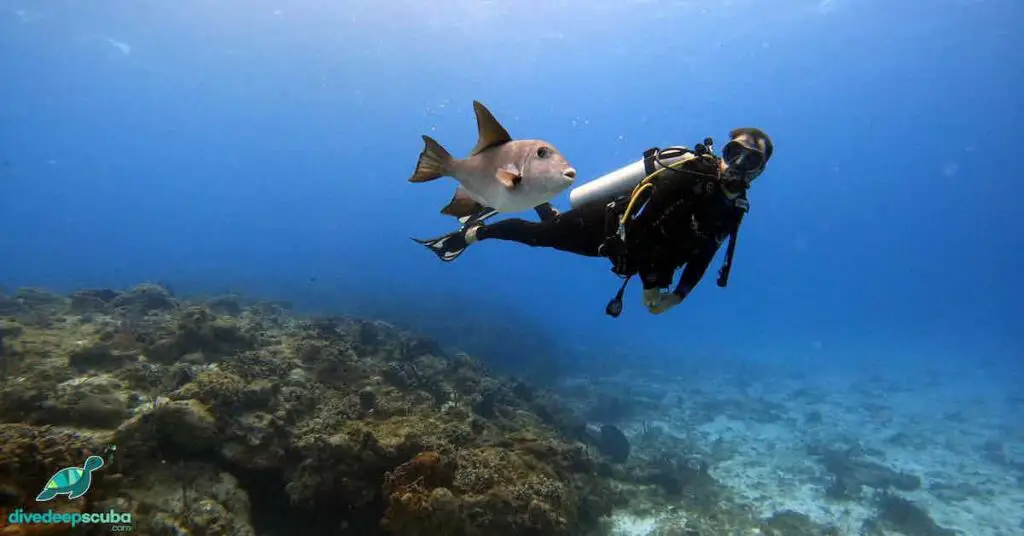
Analog Gauges:
When selecting analog gauges, consider the following factors:
- Visibility: Choose gauges with large, clear, and easy-to-read markings to ensure you can quickly access your dive information.
- Gauge Set: Many divers opt for a gauge set that includes an air pressure gauge (SPG), depth gauge, and compass. This combination provides essential information in a compact and convenient package.
- Durability: High-quality gauges should be durable and resistant to corrosion, as they’ll be exposed to saltwater and other harsh conditions. Look for gauges with sturdy housings and reliable mechanisms.
- Hose Length: Consider the hose length that best suits your diving style and configuration. Longer hoses can provide more flexibility, while shorter hoses offer a more streamlined setup.
By understanding the features and considerations for dive computers and analog gauges, you’ll be well-equipped to select the ideal instruments for your diving adventures.
In our final section, we’ll discuss essential accessories and maintenance tips to keep your scuba gear in top condition.
Selecting the Right Dive Accessories for Your Needs
While having the right core scuba gear is crucial, selecting the right dive accessories can enhance your diving experience and ensure your safety.
In this section, we’ll discuss some of the most useful dive accessories and provide tips on choosing the ones that best suit your needs.
- Dive Knife or Cutting Tool:
A dive knife or cutting tool is essential for emergencies, such as entanglements or cutting lines. When selecting a dive knife, consider the following:
- Material: Choose a corrosion-resistant material, such as stainless steel or titanium.
- Size: A compact, lightweight knife is easier to carry and handle underwater.
- Attachment: Ensure the knife can be securely attached to your gear for easy access.
- Surface Marker Buoy (SMB) and Reel:
An SMB and reel help signal your position to boats and other divers when surfacing. Look for these features:
- Visibility: Choose a brightly colored, inflatable SMB for maximum visibility.
- Durability: Opt for a sturdy reel with a reliable line that can withstand regular use.
- Ease of Use: Ensure the SMB and reel can be easily deployed and retrieved.
- Dive Light:
A dive light is essential for low-visibility conditions, night dives, or exploring underwater caves and wrecks. Consider the following when choosing a dive light:
- Brightness: Look for a high-lumen light that provides sufficient illumination.
- Battery Life: A long battery life ensures your light lasts throughout your dive.
- Durability: Opt for a rugged, waterproof light that can withstand the demands of diving.
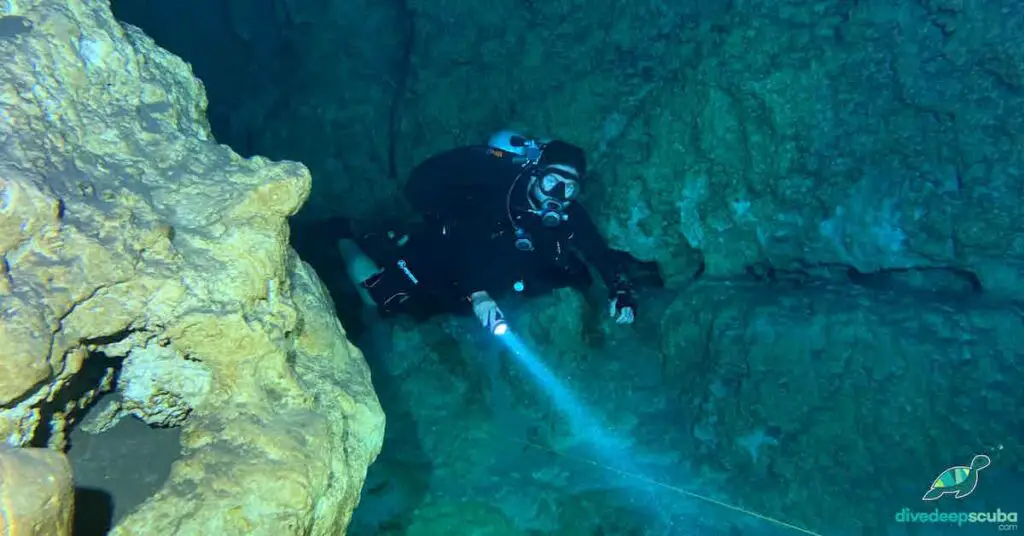
- Mesh Gear Bag:
A mesh gear bag allows you to easily transport and store your scuba gear. Consider these factors when selecting a gear bag:
- Size: Ensure the bag has ample storage capacity for your gear.
- Material: Opt for a durable material that allows air circulation and water drainage.
- Comfort: Look for a bag with sturdy handles or straps for easy carrying.
- Underwater Camera or Action Camera:
Capturing your underwater adventures can be a rewarding experience.
When selecting a camera, consider:
- Waterproof Rating: Ensure the camera is rated for the depths you plan to dive.
- Image Quality: Look for a camera that offers high-resolution images and videos.
- Ease of Use: Choose a camera with user-friendly controls and settings.
By selecting the right dive accessories for your needs, you’ll not only enhance your diving experience but also ensure your safety and comfort underwater. In the next section, we’ll delve into understanding dive computers and analog gauges to help you monitor crucial dive information.
Top Scuba Gear Brands and Recommendations for Beginners
When it comes to scuba diving gear, choosing products from reputable brands can make a significant difference in terms of quality, safety, and performance. In this section, we’ll introduce you to some of the top scuba gear brands and provide recommendations for beginners.
- Cressi:
Cressi is an Italian company with a long-standing reputation for producing high-quality diving gear. They offer a wide range of products, from masks and fins to wetsuits and regulators.
Beginner Recommendation: The Cressi Start Pro BCD is an affordable and reliable choice for new divers, featuring a simple design and comfortable fit.
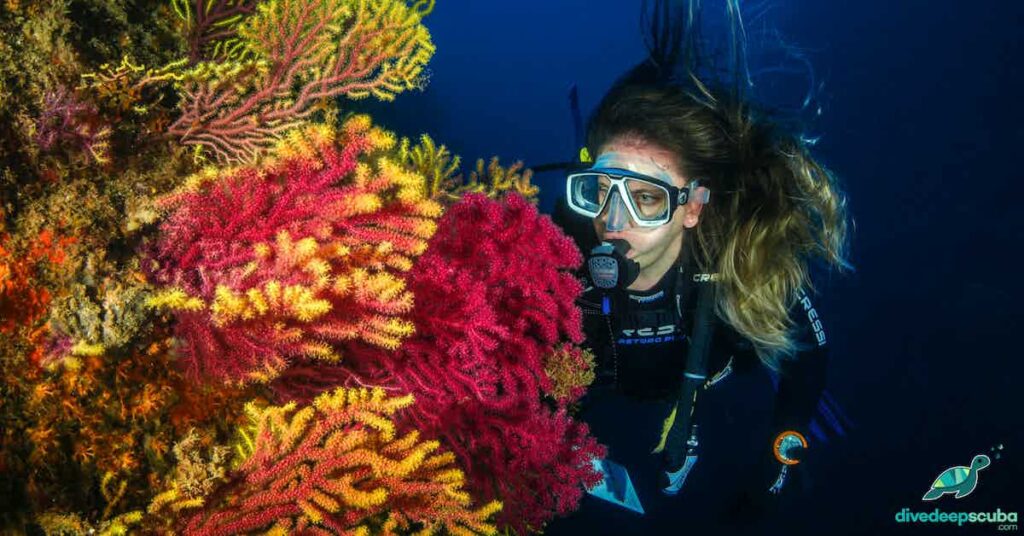
- Scubapro:
Scubapro is known for its innovative and reliable scuba gear, including regulators, BCDs, and dive computers. They focus on durability and performance, making them a popular choice among divers.
Beginner Recommendation: The Scubapro MK2 Evo R195 regulator offers excellent performance and ease of use, making it an ideal choice for new divers.
- Aqua Lung:
Aqua Lung is a well-known brand in the diving world, offering a wide variety of gear, from masks and snorkels to regulators and BCDs. Their products are designed for both recreational and professional divers.
Beginner Recommendation: The Aqua Lung Pro HD BCD is a feature-rich and affordable option for new divers, offering integrated weights, multiple pockets, and adjustable straps for a comfortable fit.
- Mares:
Mares is another reputable brand, known for its innovative designs and high-quality gear. They offer products for all skill levels, including beginner-friendly options.
Beginner Recommendation: The Mares Prestige 15X regulator provides a great combination of performance, durability, and affordability, making it an excellent choice for new divers.

- Oceanic:
Oceanic is a well-respected brand that focuses on creating reliable and user-friendly dive gear. Their products include dive computers, regulators, BCDs, and more.
Beginner Recommendation: The Oceanic Veo 2.0 dive computer is an easy-to-use and budget-friendly option for new divers, providing essential information in a compact and intuitive design.
By selecting gear from reputable scuba brands, you’ll ensure a safe and enjoyable diving experience.
Don’t hesitate to consult with experienced divers or instructors for personalised recommendations.
In the next section, we’ll cover essential accessories and maintenance tips to keep your scuba gear in top condition.
Renting vs. Buying: Making the Best Decision for Your Scuba Gear
As a beginner diver, you may be wondering whether to rent or buy your scuba gear. Both options have their pros and cons, and the best choice depends on your individual needs, budget, and diving frequency.
In this section, we’ll discuss the advantages and disadvantages of renting vs. buying scuba gear to help you make an informed decision.
Renting Scuba Gear:
Pros:
- Lower upfront cost: Renting gear is less expensive in the short term, making it a more accessible option for those new to diving or on a tight budget.
- No maintenance: Renting means you don’t need to worry about maintaining or servicing your gear, as the dive shop takes care of that.
- Travel convenience: When traveling to dive destinations, renting gear can save you the hassle of transporting bulky equipment.
Cons:
- Limited selection: Rental gear may not always be available in the exact size, style, or brand you prefer, potentially impacting your comfort and performance underwater.
- Hygiene concerns: Although rental gear is cleaned and sanitized, some divers may feel uncomfortable using equipment that has been worn by others.
- Long-term costs: If you dive frequently, the cumulative cost of renting gear can exceed the cost of purchasing your equipment over time.

Buying Scuba Gear:
Pros:
- Customization: Owning your gear allows you to choose the exact equipment that best suits your needs, preferences, and fit, ensuring a more comfortable and enjoyable diving experience.
- Cost-effective in the long run: If you dive regularly, investing in your gear can be more cost-effective over time compared to renting.
- Familiarity: Using your equipment helps you become familiar with its features and functionality, potentially increasing your safety and confidence underwater.
Cons:
- Higher upfront cost: Purchasing your scuba gear requires a larger initial investment compared to renting.
- Maintenance responsibility: Owning gear means you’re responsible for its maintenance, servicing, and storage, which can be time-consuming and costly.
- Travel considerations: Transporting your gear when traveling to dive destinations may require additional planning and luggage fees.
To make the best decision, consider factors such as your diving frequency, budget, and personal preferences.
If you’re new to diving or dive infrequently, renting may be the better option.
However, if you’re committed to the sport and plan on diving regularly, investing in your gear can provide a more personalized and cost-effective experience.
Tips for Finding the Best Scuba Gear Deals and Discounts
Investing in scuba gear can be expensive, but there are ways to find deals and discounts to help you save money. Here are some tips to help you score the best deals on your scuba equipment:
- Shop during sales events: Keep an eye out for sales events, such as end-of-season sales, Black Friday, Cyber Monday, or holiday sales. These events often feature significant discounts on scuba gear.
- Check out clearance or discontinued items: Retailers may offer discounts on clearance or discontinued items to make room for new inventory. This can be a great opportunity to find high-quality gear at reduced prices.
- Compare prices online: Use price comparison websites or browse multiple online retailers to find the best deals on the gear you’re looking for. Keep in mind that some retailers may offer free shipping or other incentives that could make their prices more competitive.
- Join scuba diving forums or social media groups: Online scuba diving communities can be a valuable source of information on deals and discounts. Members often share promotions, sales, and personal experiences with different retailers, helping you make informed decisions.
- Visit local dive shops: Local dive shops may offer special promotions, package deals, or discounts on gear that isn’t advertised online. Building a relationship with your local dive shop can also give you access to insider tips and recommendations.
- Consider buying used gear: Purchasing gently used gear from fellow divers or online platforms can save you money while still providing reliable equipment. Just be sure to thoroughly inspect the gear and, when necessary, have it serviced before use.
By following these tips and staying informed about deals and discounts, you can find high-quality scuba gear at more affordable prices.
This will allow you to invest in the equipment you need without breaking the bank.

Scuba Gear Maintenance and Storage Tips
Proper maintenance and storage of your scuba gear are essential for ensuring its longevity and functionality.
By taking care of your equipment, you’ll be able to enjoy safe and comfortable dives for years to come.
Here are some tips for maintaining and storing your gear:
- Rinse thoroughly: After each dive, rinse your gear with fresh water to remove salt, sand, and other debris. This helps prevent corrosion and damage to your equipment.
- Dry properly: Allow your gear to air-dry in a shaded, well-ventilated area. Avoid direct sunlight, as it can cause damage to certain materials.
- Inspect regularly: Check your gear for signs of wear and tear, such as cracks, leaks, or loose parts. Address any issues promptly to prevent further damage or potential safety risks.
- Service as needed: Follow the manufacturer’s recommendations for servicing your gear, such as regulators and BCDs. Regular servicing helps ensure optimal performance and safety.
- Store correctly: Store your gear in a cool, dry place away from direct sunlight and extreme temperatures. Use padded bags or containers to protect your equipment from damage.
- Protect against mold and mildew: Wetsuits and other neoprene items should be stored with moisture-absorbing packets or hung in a well-ventilated area to prevent mold and mildew growth.
Don’t Forget Your Dive Insurance!
Before you go out on any dive trip or holiday, it is essential to make sure you have insurance that covers you if something goes wrong. Check out our dive insurance article for more information.
Or go straight to these dive insurance company websites:
Final Thoughts
Entering the world of scuba diving is an exciting adventure, and choosing the right gear is a crucial step in ensuring a safe and enjoyable experience. By considering factors such as fit, comfort, and functionality, you can make informed decisions about the equipment that best suits your needs.
Understanding the pros and cons of renting vs. buying, as well as knowing where to find the best deals and discounts, can help you invest in your gear without breaking the bank.
Proper maintenance and storage will ensure the longevity and performance of your equipment, allowing you to focus on the incredible underwater world that awaits you.
With this ultimate guide, you now have the expert tips and recommendations needed to make the best choices for your first scuba diving gear. So gear up, dive in, and explore the wonders of the deep blue sea.
Happy diving!
Please share this article using the social media buttons!
